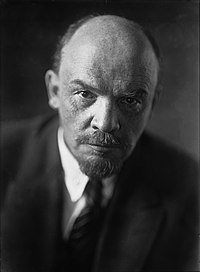|
Vikidia currently has 4,626 articles. Improve it! |
|
Join Vikidia: create your account now and improve it! |
Vladimir Lenin
Vladimir Ilyich Oulianov (22 April 1870 - 21 January 1924) who used the alias Lenin, was a Russian revolutionary and first leader of the Soviet Union. Born in Simbirsk, Russia and died in Gorki, Soviet Union after a series of strokes resulting from an assassination attempt. His embalmed body is on permanent exhibition in Moscow.
Early life[edit | edit source]
Lenin was the son of a (government jobs) official, and distinguished himself in the study of Latin and Greek. In May 1887, his oldest brother Alexander was hanged for for participation in a plot on the life of Powerful ruler Alexander III. This radicallized Lenin and later that year he was arrested, and expelled from Kazan University for participating in student protests. He continued to study independently and by 1892 he gained a license to practise law.
Before the revolution[edit | edit source]
However, rather that settle into a legal career he became more involved in (talk or information that tries to change people's minds) efforts, and the study of Marxism, much of it in St. Petersburg. On 7 December 1895, he was arrested and held by people in charge for a whole year, followed by (permanent removal from a country) to Siberia.
In July of 1898 he marriest N.K. Krupskaya and in April 1899, he publishes the book The Development of (a system where people own money and valuable things) in Russia. In 1900, his (permanent removal from a country) ends. He travelled in Russia and Europe, and published the paper Iskra as well as other areas (of land) and books related to the movement.
He is active in the Russian Social Democratic Labor Party (RSDLP), and in 1903, he leads the Bolshevik group of people (involved in a battle) after the split with the Mensheviks in 1903, that was partly given great ideas from his (very short, small book) What is to be Done?. In 1906, he is elected to the Presidium of the RSDLP. In 1907, he moves to Finland for security reasons. He continues to travel in Europe and partipate in many socialist meetings and activities.
October Revolution[edit | edit source]
In 1917, he returns to Petrograd after Powerful ruler Nicholas II gives up and takes a leading role with the Bolsheviks publishing the April (statements for discussion/books written for college professors). After a failed Bolshevik violent effort by a group of people in July Lenin runs away to Finland, and returns in October to successfully lead an armed secret and successful plan against the Kerensky temporary government.
A Soviet government is formed with Lenin as Chairman. It is a dictatorship. In August 1918, he survives a failed murder attempt by Fanny Kaplan.
In 1921, on Lenin's effort to begin (doing something), the New Money-based Policy (NEP) was adopted, allowing a limited amount of private business in an attempt to rebuild industry and especially agriculture.
Final years and Death[edit | edit source]
In May 1922, Lenin has his first stroke. His role in government declines and in after a second stroke in December the Politburo order that he be kept (completely separate from others). In March 1923, he suffers a third stroke and is no longer able to speak and dies of a fourth stroke in January 1924.
After his first stroke he published some papers pointing to/showing future directions for the government and critisizing Stalin; however, some of these were suprressed for decands and after his death Stalin gained control the party.
Links[edit | edit source]
| Politics Portal — All articles about politics and politicians ! |




